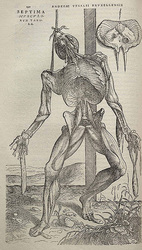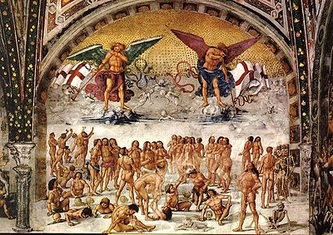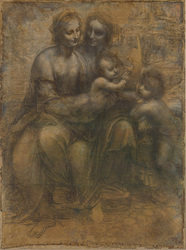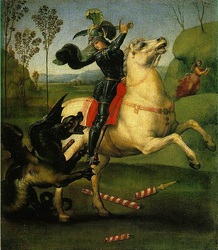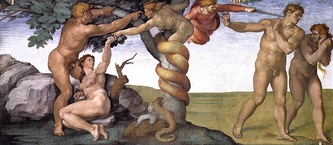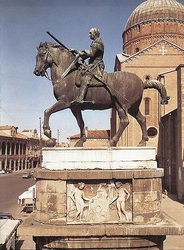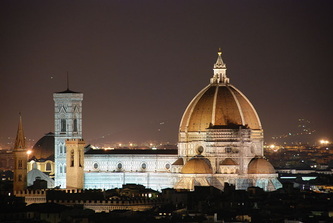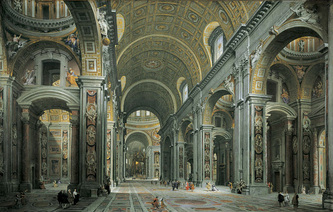Renaissance Literature and Music

The Lute Player, Caravaggio, 1595.
Philosophy, technology, and a changing culture affected literature greatly in the Renaissance. The invention of the printing press in the 1440s by Johannes Gutenburg revolutionized media and education. Previously, texts were hand-written in Classical languages that only the elite could read and afford. Gutenburg's printing press allowed many texts to be copied for a cheaper price. In addition, texts could now be translated into any language and were more accessible to the public. This is significant because it essentially ended the Church's control over the written language.
Literature in this era was also blossoming. The themes, styles, and inspirations for Renaissance literature vary from country to country. Famous Renaissance writers used these new elements to create timeless literature. For instance, Shakespeare used his unique understanding of the human nature to write pieces based on themes such as revenge, passion, and betrayal. He also makes many references to Greek and Rome in his works. Here we see, again, that the humanist movement in Europe led to a secularization of literature as well as science. Renaissance writers, such as Shakespeare, were also inspired by the Greek and Roman theatrical tradition.
Renaissance music was also affected by the invention of the printing press. Sheet music could be printed and distributed in the same way as texts. The Renaissance ushered in an era of music with more vitality and less complexity than that of the Middle Ages. Additionally, new instruments were invented and old ones improved upon.
Literature in this era was also blossoming. The themes, styles, and inspirations for Renaissance literature vary from country to country. Famous Renaissance writers used these new elements to create timeless literature. For instance, Shakespeare used his unique understanding of the human nature to write pieces based on themes such as revenge, passion, and betrayal. He also makes many references to Greek and Rome in his works. Here we see, again, that the humanist movement in Europe led to a secularization of literature as well as science. Renaissance writers, such as Shakespeare, were also inspired by the Greek and Roman theatrical tradition.
Renaissance music was also affected by the invention of the printing press. Sheet music could be printed and distributed in the same way as texts. The Renaissance ushered in an era of music with more vitality and less complexity than that of the Middle Ages. Additionally, new instruments were invented and old ones improved upon.
Art and the Renaissance
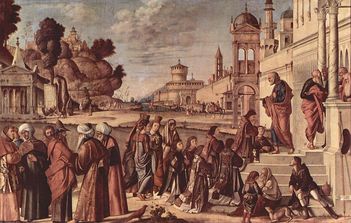
St. Stephen Consecrated Deacon by Vittore Carpaccio, c. 1514
The progress of European culture during the Renaissance had an immense impact on art. In previous eras, artists were known as skilled craftsmen and typically produced works commissioned by those who could afford it. The Renaissance saw a blossoming of these "craftsmen" into true artists. Renaissance artists also worked by commission, but the patrons of art in Renaissance Europe had changed greatly. Due to the growth of the European economy, a rising merchant class was able to fund the arts. As a result, there was a proliferation not only in the amount and quality of art produced, but also in the themes we see in Renaissance art. Many of the new, wealthy merchant class were Humanists and self-made citizens. They had a different outlook on religion and society than the aristocracy (who inherited their wealth and power) of that time.
It is also important to note the effects of scientific progress on art. Artists in the Renaissance era began to study mathematics to create more realistic art. Notions of perspective and ratio became essential in creating works of art that seem almost real, such as the Mona Lisa or Michelangelo's David. Artists also began a comprehensive study of the human body--through dissection and the analysis of skeletal and muscular systems--to paint and sculpt figures that were more representational and accurate. The return to classical thinking also resurrected a reverence for the human form and many pieces from the Renaissance depict nude figures. Thus, it was essential to have an understanding of the inside of the human body, as well as the outside. Compare Renaissance art to the art from different periods. It is easy to see the difference in the quality of representation. Renaissance artists had a profound understanding of the world around them in mathematical terms. The painting above is an excellent example of the use of linear perspective in painting in the Renaissance era. The Renaissance pieces below demonstrate the study of anatomy and physiology by the artists of that era. Notice how realistic the proportions and musculature appear.
It is also important to note the effects of scientific progress on art. Artists in the Renaissance era began to study mathematics to create more realistic art. Notions of perspective and ratio became essential in creating works of art that seem almost real, such as the Mona Lisa or Michelangelo's David. Artists also began a comprehensive study of the human body--through dissection and the analysis of skeletal and muscular systems--to paint and sculpt figures that were more representational and accurate. The return to classical thinking also resurrected a reverence for the human form and many pieces from the Renaissance depict nude figures. Thus, it was essential to have an understanding of the inside of the human body, as well as the outside. Compare Renaissance art to the art from different periods. It is easy to see the difference in the quality of representation. Renaissance artists had a profound understanding of the world around them in mathematical terms. The painting above is an excellent example of the use of linear perspective in painting in the Renaissance era. The Renaissance pieces below demonstrate the study of anatomy and physiology by the artists of that era. Notice how realistic the proportions and musculature appear.
Themes, Symbolism and Technique in Renaissance Art

Sacred and Profane Love by Giovanni Baglione, c. 1602.
In addition to the use of mathematics and anatomy in Renaissance art, other new techniques were developed. The painting on the left is an excellent example of chiaroscuro, which was developed during the Renaissance. Chiaroscuro is the use of light and shadow in compositions. Here we see bold contrasts between the piece which give it depth, volume and a 3-D effect. The Renaissance movement toward true representational art becomes ever more apparent with the use of this technique. Another technique developed during the Renaissance was sfumato which is attributed to Leonard Da Vinci. Da Vinci's unfinished painting below this section demonstrates the blurred lines and soft "smoky" appearance that characterizes sfumato. Careful attention was also paid to the use of color, balance, and the overall composition of the work during this time. New techniques in color also made Renaissance era paintings more vibrant and lended more variety for the artist to use. In eras past, art was a craft dominated by the church. Artists took commissions for and used thier talents to mainly promote God's glory. The revival of interest in Classical times saw a change in many themes of Renaissance art. Artists painted landscapes, drew different kinds of portraits, and scenes (and sculptures) depticting Greek and Roman culture and mythology--in addition to religious art. This secular trend was a direct result of Humanism. Look at the paintings below and the style, themes and techniques of the Renaissance--including balance and overall composition--will become evident.
Sculpture of the Renaissance
Renaissance sculptors also made significant improvements in their techniques. For instance, sculptors began using bronze as media for thier pieces. Bronze, an alloy of copper and tin, had been known to mankind for a long while. This is yet another notion borrowed from the Ancient Greeks and Romans, who were very fond of bronze art. Bronze casting allows for more intricate detail and design to be laid into the sculpture. Also, Renaissance sculptors used contrapposto in their pieces to give their work a more elegant, natural feel. This was another idea borrowed from the Greeks and Romans. Look at the sculptures below and notice their posture and position. You will notice that they borrow not only posture, but theme as well, from the Ancient ages.
The Renaissance and Architecture
Finally, the Renaissance era ushered in new advancements in architecture. During the Middle Ages, architecture was based largely on intuition. Filippo Brunelleschi was a pioneer and first developed a mathematical reasoning of linear perspective. Using vanishing points and optical testing, he could accurately draw illustrations of what his final product would look like. Two of his most famous buildings can be seen below. Another aspect of Renaissance architecture can be seen in its influence by Roman architecture. Close attention was paid to symmetry, proportion and geometry when designing structures. The adornment and details of Renaissance structures are also similar to the Classical style. Brunelleschi was so inspired by Ancient architecture that his Florence Cathedral was greatly inspired by the Greece's Pantheon, as were many other buildings from the era.
